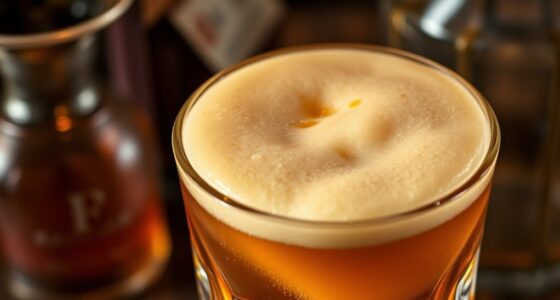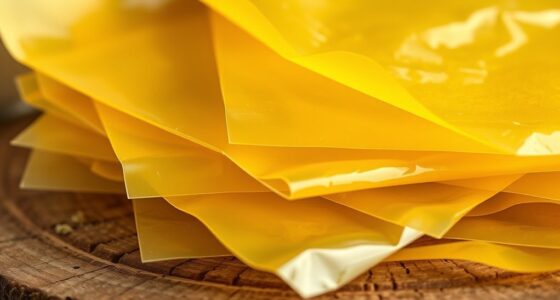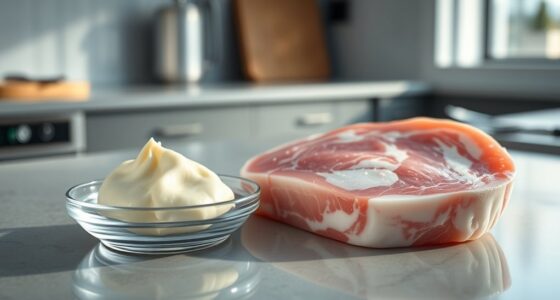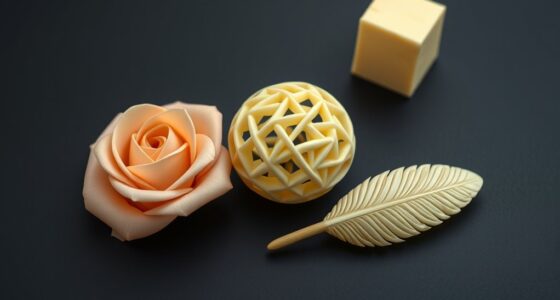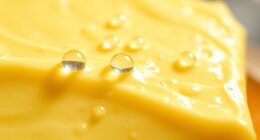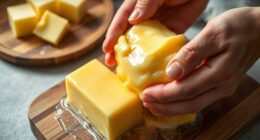AI-generated butter recipes blend traditional techniques with innovative twists, inspired by diverse cultural influences. When you test these recipes, you’ll notice how they emphasize flavor, texture, and practicality, often using common ingredients for easy home reproduction. You’ll see how AI captures culinary history and creativity while offering reliable guidance. If you keep exploring, you’ll discover how these recipes compare to traditional methods and uncover unexpected flavors and textures that can elevate your culinary skills.
Key Takeaways
- AI-generated butter recipes blend traditional culinary patterns with innovative flavor pairings inspired by diverse cultural influences.
- Recipes emphasize practicality, using common ingredients and straightforward steps for easy home testing and adaptation.
- Sensory evaluation focuses on flavor nuances, texture, and melting behavior to refine and optimize each recipe.
- Cultural and historical contexts subtly influence recipe techniques and flavor profiles, enhancing authenticity and depth.
- Comparing AI recipes to traditional methods reveals differences in craftsmanship, ingredient sourcing, and emphasis on authenticity versus efficiency.
The Concept Behind AI-Generated Butter Recipes
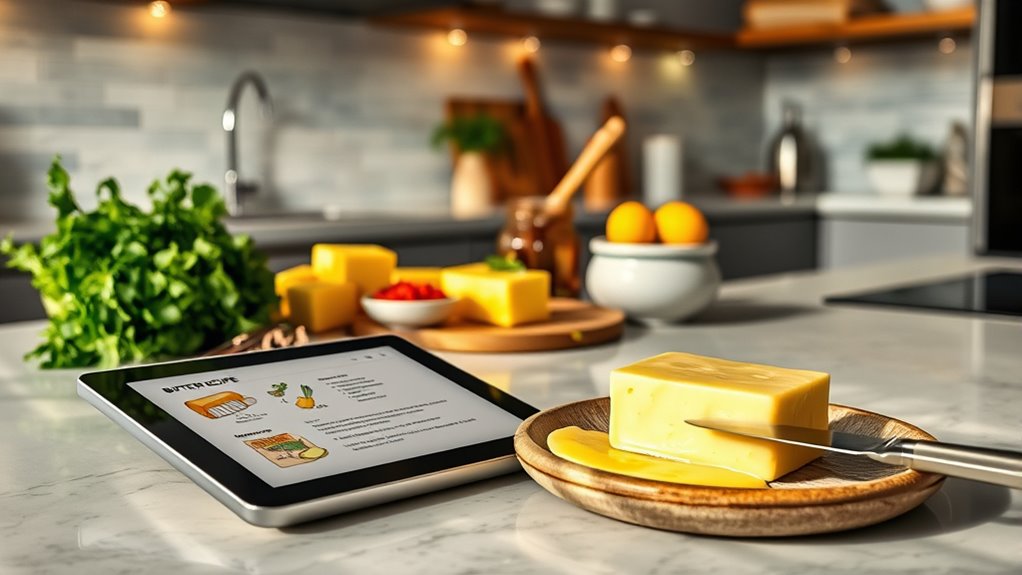
AI-generated butter recipes are created by algorithms that analyze vast amounts of culinary data to identify patterns and successful flavor combinations. By examining the butter history, these algorithms understand how different cultures have used butter and evolved its uses over time. They also assess flavor profiles, recognizing which ingredients complement butter’s richness and texture. This process allows the AI to craft innovative recipes that blend traditional elements with modern twists. Instead of relying solely on human intuition, the system predicts which flavor pairings are most likely to succeed, offering fresh ideas rooted in centuries of butter usage. Additionally, these algorithms incorporate cultural influences to ensure the recipes resonate across diverse culinary traditions, resulting in unique recipes that honor butter’s rich history while exploring new taste combinations with precision and creativity.
Selecting the Recipes to Test

When choosing recipes to test, focus on variety to showcase different flavors and techniques. Make sure the ingredients are easy to find so you can replicate the recipes without hassle. Balancing diversity and accessibility helps you select the most interesting and practical options. Additionally, considering how the textures and presentation will translate in different lighting conditions can enhance the overall experience. Color accuracy in presentation can make a significant difference in how appealing the dishes appear.
Recipe Diversity
Have you considered how diverse your butter recipes should be to truly showcase the potential of AI? Selecting a variety of recipes allows you to explore different cultural influences and dietary variations. For example, you might include traditional European herb butters, Asian-inspired spicy blends, or plant-based vegan options. Incorporating this diversity guarantees AI can generate creative, culturally rich recipes that appeal to a broad audience. It also highlights how AI can adapt to various dietary needs, from dairy-free to low-fat options. By thoughtfully choosing recipes that reflect different culinary traditions and dietary preferences, you maximize the showcase of AI’s versatility. This approach demonstrates that AI can generate not just novel recipes but culturally and dietarily inclusive ones. Creating a cohesive theme in your selection process helps ensure the recipes are both diverse and harmoniously integrated, enhancing the overall presentation.
Ingredient Accessibility
How you select recipes based on ingredient accessibility plays a crucial role in testing AI’s versatility. You focus on ingredient availability to guarantee that each recipe can be made with common, easily obtainable items. This approach guarantees that the recipes are practical and accessible for most users, avoiding obscure or hard-to-find ingredients. By prioritizing recipe accessibility, you also streamline the testing process, making it easier to evaluate AI’s ability to generate feasible and appealing butter-based dishes. Considering ingredient availability helps you avoid unnecessary complications and ensures that the recipes reflect real-world cooking conditions. Ultimately, this method guarantees that the AI’s creations are both innovative and achievable, making the testing process more relevant and useful for everyday cooks. Additionally, understanding the dog names that resonate well with different breeds can inspire creative and fitting name choices for your culinary projects.
Preparing the Ingredients and Setting Up
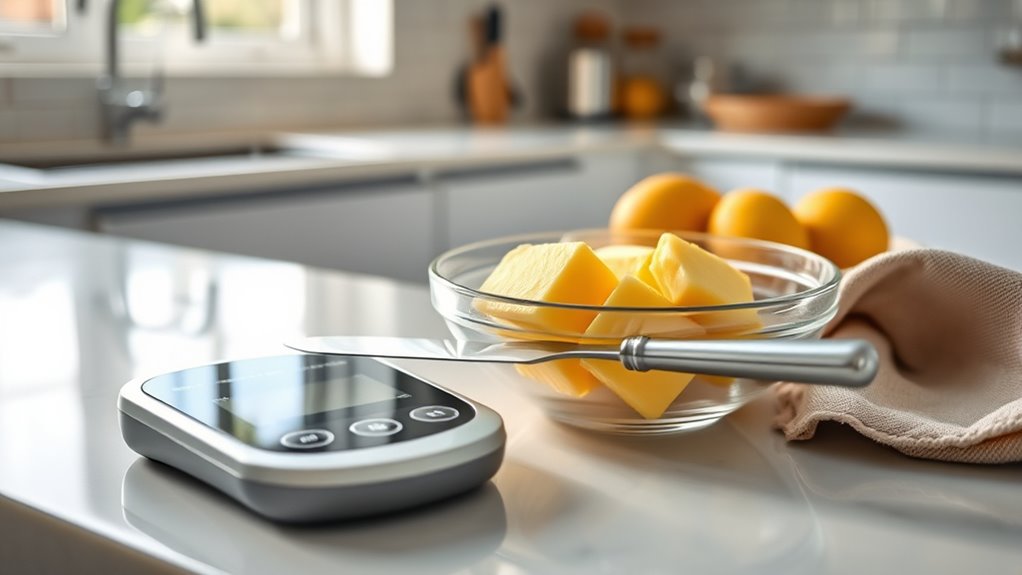
Start by choosing high-quality butter to guarantee the best flavor and texture. Gather your essential tools, like mixing bowls and spatulas, so everything’s ready to go. Organize your ingredients efficiently to keep your workflow smooth and avoid any last-minute searches. Additionally, reviewing best butter choices can help ensure you select the most suitable product for your recipe.
Choosing Quality Butter
Choosing the right butter is essential for achieving the best results in your recipes. High-quality butter enhances flavor and guarantees proper texture. Look for butter with a fresh, clean aroma and a creamy, consistent color. Unsalted butter is preferable for better control over seasoning and flavor enhancement. Organic or grass-fed options often provide richer taste and better butter quality. To help you decide, here’s a quick guide:
| Butter Type | Flavor Profile | Best Use |
|---|---|---|
| Unsalted | Pure, clean taste | Baking, recipes needing control |
| Salted | Slightly savory flavor | Spreading, finishing touches |
| Grass-fed | Richer, nuttier flavor | Flavor-intensive recipes |
Choosing quality butter makes a noticeable difference in your final dish. Additionally, selecting butter with high-fat content can improve the richness and texture of your baked goods.
Gathering Essential Tools
Before you begin crafting your butter recipes, gathering the right tools and preparing your ingredients is crucial. A sharp knife and sturdy cutting board are indispensable for butter art, allowing precise shaping and decoration. Measuring cups and spoons ensure accurate ingredient ratios, respecting culinary history’s emphasis on balance. A warm, clean workspace helps maintain the butter’s texture and prevents contamination. Consider a silicone spatula for mixing and shaping, which offers flexibility and control. Understanding the history of butter in cuisine can inspire your setup, connecting traditional techniques with modern AI creativity. Having your tools ready streamlines the process, letting you focus on the art of butter craftsmanship. Proper preparation sets the foundation for successful, visually appealing butter creations rooted in culinary history.
Organizing Ingredients Efficiently
Once your tools are in place, organizing your ingredients efficiently helps streamline the butter crafting process. Arrange your butter, flavorings, and any optional ingredients within easy reach. Consider ingredient substitutions beforehand, so you can adapt recipes based on what you have available or to suit dietary needs. Group ingredients by flavor pairings to enhance efficiency—pair complementary flavors like honey and cinnamon or herbs and garlic. Label jars or bowls to avoid confusion during preparation. Keep your workspace tidy to prevent spills and mix-ups. A well-organized setup minimizes downtime, allowing you to focus on creating perfect butter blends. Understanding self watering plant pots can also inspire you to design a more efficient workspace with self-sustaining features. This preparation stage ensures smooth mixing and helps you quickly adapt recipes, making your butter-making process more enjoyable and efficient.
First Impressions: Following the AI’s Instructions

When you follow the AI’s butter recipe instructions closely, the results often meet expectations quickly, offering a sense of confidence in the process. The AI’s guidance reflects cultural influences, blending traditional techniques with modern preferences, which can lead to unique flavor profiles. It also incorporates historical context, such as classic methods from different regions, making the process educational and engaging. You might notice subtle nuances—like the choice of culture or churning method—that echo cultural diversity. This integration of history and culture helps create a more authentic and well-rounded butter. Additionally, understanding Glycolic Acid benefits can inform skincare routines that complement the overall wellness of your skin. Overall, adhering to the instructions provides a straightforward experience, but staying mindful of these influences enriches your understanding and appreciation of the craft behind butter-making.
Tasting and Texture Analysis

Tasting and texture analysis bring your homemade butter to life, revealing how well your efforts paid off. As you sample your creation, pay attention to flavor enhancement—note if the butter’s richness and subtle nuances meet your expectations. Texture variation plays an essential role; assess whether it’s smooth, creamy, or has desirable firmness. Consider if the AI-generated recipe resulted in a balanced mouthfeel or if adjustments are needed. The way the butter melts on your palate provides insight into its quality and potential uses. Take notes on any off-flavors or inconsistencies that could affect future batches. This step guarantees you understand how the recipe’s ingredients and techniques influence the overall sensory experience, guiding you toward perfecting your homemade butter. Additionally, evaluating the relationship between texture and flavor can help refine your process for consistently delicious results.
Comparing AI Recipes to Traditional Methods

Comparing AI-generated butter recipes to traditional methods reveals notable differences in approach, ingredients, and results. Traditional recipes often reflect cultural influences and historical context, shaping regional flavors and techniques passed down through generations. These methods emphasize artisanal processes, local ingredients, and nuanced craftsmanship. In contrast, AI recipes rely on vast data sets, blending diverse influences without cultural specificity, leading to innovations or simplified versions. While traditional methods may prioritize authenticity and heritage, AI approaches focus on efficiency and experimentation. Both methods produce delicious butter, but their foundations differ: one rooted in history and cultural identity, the other in data-driven exploration. Understanding these differences highlights how cultural heritage can be complemented, but not replaced, by technology and data in culinary innovation.
Unexpected Results and Surprising Flavors
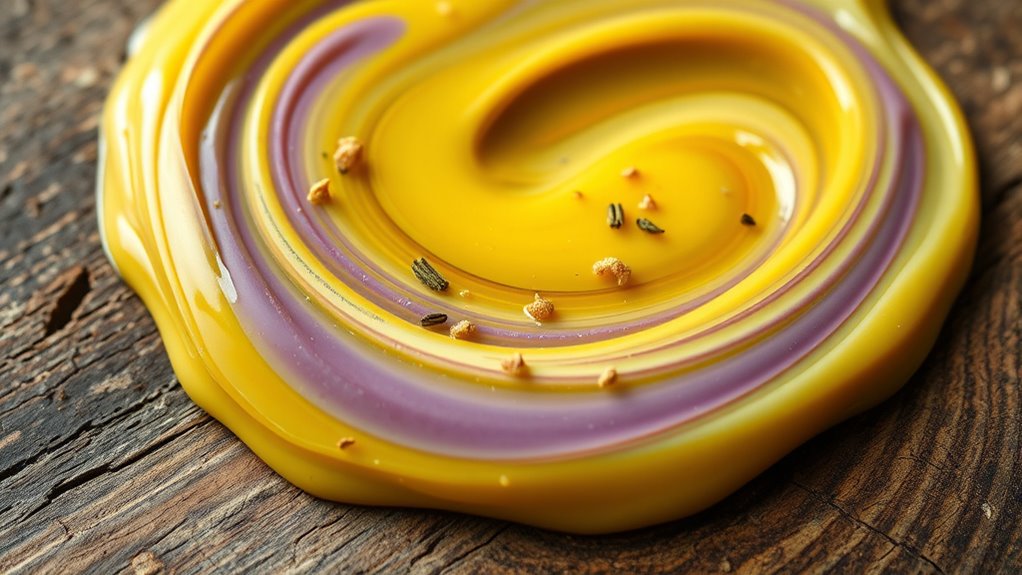
AI-generated butter recipes often produce unexpected results and surprising flavors that can catch even seasoned cooks off guard. You might encounter flavor surprises, like sweet or savory notes that don’t match traditional expectations. These recipes sometimes create texture inconsistencies, resulting in butter that’s either too soft, grainy, or overly dense. Such anomalies can be frustrating but also intriguing, pushing you to explore new taste combinations or adjust techniques. Sometimes, the AI’s creative mix leads to delightful discoveries, while other times, it results in odd flavor pairings or unpalatable textures. Embracing these surprises can expand your culinary horizons, but it’s important to stay adaptable and ready to tweak the recipes to achieve the desired consistency and flavor balance.
Practicality and Ease of Reproduction at Home
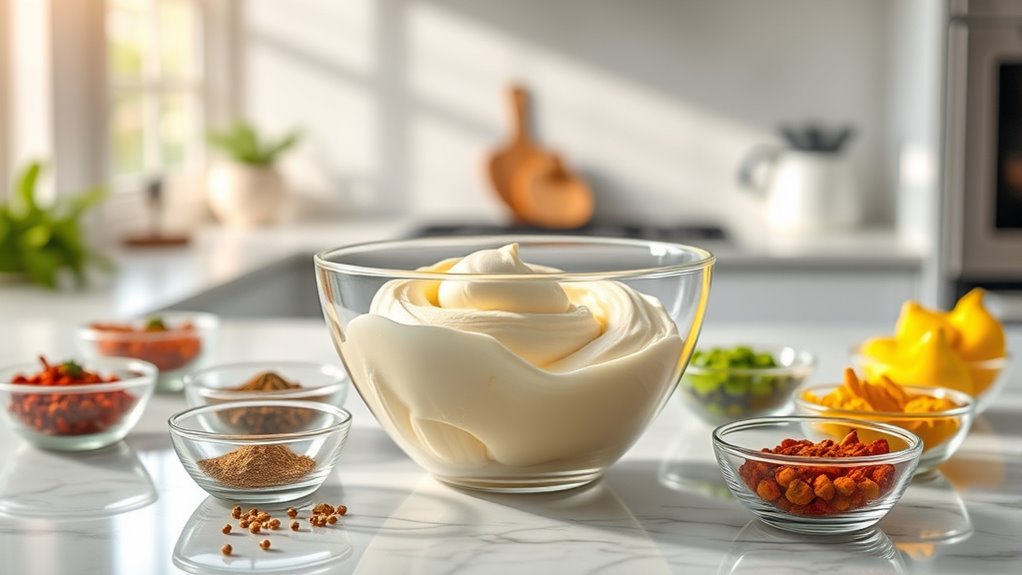
Creating AI-inspired butter recipes at home is generally practical and straightforward, especially since most ingredients are common pantry staples. You can easily adapt recipes with ingredient substitutions to suit your preferences or dietary needs, making the process flexible. The steps are simple: melt, mix, and chill, which doesn’t require specialized equipment. Flavor variations are simple to experiment with; add herbs, spices, or sweeteners to customize your butter. AI-generated recipes often specify accessible ingredients, so recreating them is feasible for most home cooks. Plus, the ability to tweak flavors and ingredients means you can craft unique butter spreads without much effort. Overall, these recipes are user-friendly, requiring minimal culinary skill, and are easily reproducible, making them a practical addition to your kitchen repertoire.
Final Thoughts on AI’s Role in Culinary Creativity

While AI continues to expand its influence in the culinary world, it serves as a powerful tool rather than a complete replacement for human creativity. AI’s role is to inspire and enhance your artistic expression, offering new flavor combinations and innovative techniques you might not have considered. It can help you explore cultural significance by recreating traditional recipes or inventing fusion dishes that celebrate diverse culinary heritages. However, the soul of cooking still lies in your personal touch, intuition, and cultural understanding. AI can support your creativity, but it doesn’t replace the emotional connection and storytelling behind each dish. Embracing AI as a collaborative partner allows you to push culinary boundaries while honoring the cultural and artistic roots that make food meaningful.
Frequently Asked Questions
How Does AI Generate Unique Butter Recipes?
AI generates unique butter recipes by analyzing vast data on flavor combinations and texture enhancements. It identifies patterns and suggests innovative pairings you might not think of, combining ingredients to create new taste experiences. By adjusting proportions and incorporating various flavors, AI helps you craft personalized recipes that stand out. This process streamlines experimentation, making it easier for you to explore exciting butter variations with perfect textures and unexpected flavor blends.
What Challenges Are Faced When Replicating AI Recipes at Home?
Imagine trying to recreate a vivid, AI-inspired recipe at home, where AI creativity sparks unique flavors. Challenges arise in maintaining recipe authenticity, as AI often blends ingredients in ways that may not match traditional tastes. You might find it tricky to replicate the precise textures or flavors, making the process feel like chasing a fleeting shadow. Despite this, your effort brings a personal touch to AI’s inventive creations, blending technology with your kitchen.
Can AI Suggest Allergy-Friendly Butter Alternatives?
AI can suggest allergy-friendly butter alternatives by focusing on dairy-free options that suit your needs. It considers common allergens and offers flavor customization, so you get a product that tastes great and fits your dietary restrictions. With AI’s help, you can explore various plant-based spreads or oils, making it easier to find alternatives that are both safe and delicious, ensuring you enjoy your favorite recipes without allergy concerns.
How Does AI Account for Regional Ingredient Variations?
Imagine AI as a seasoned chef, blending regional flavor with ingredient availability. It accounts for regional ingredient variations by analyzing local data, much like a traveler adjusting recipes based on what’s in their pantry. AI adapts recipes to match regional tastes and ingredient access, ensuring your butter recipes reflect local traditions and ingredient availability. This way, your culinary creations stay authentic and accessible, no matter where you are.
Are Ai-Generated Recipes Suitable for Professional Culinary Use?
You might wonder if AI-generated recipes suit professional kitchens. They can, but you must consider food safety and the balance between tradition versus innovation. AI offers fresh ideas, but it’s essential to verify ingredient quality and safety standards. Use AI as a creative tool, blending new techniques with traditional methods, ensuring your dishes stay authentic while embracing innovation responsibly. This approach keeps your culinary expertise relevant and safe.
Conclusion
While AI-crafted butter recipes may not fully capture the art of tradition, they open subtle doors to new flavor horizons. You might find moments of delightful surprise amid the unexpected, gently nudging your culinary comfort zone. Embracing these digital suggestions can enrich your kitchen with quiet ingenuity, even if they don’t replace time-honored techniques. Ultimately, it’s about letting curiosity lead you, quietly blending the old and new into your own subtle, flavorful harmony.


